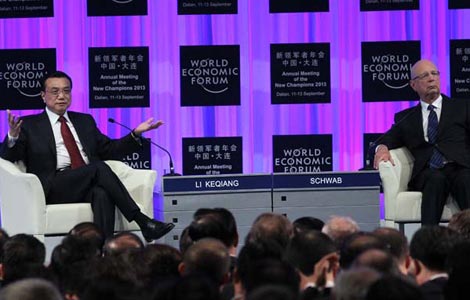US' cheap financing coming to an end
Updated: 2013-09-12 07:34
By Zhang Monan (China Daily)
|
||||||||
The dumping of US government debt by foreign investors heralds the end of the era of cheap financing for the United States. According to the US Treasury Department, overseas investors sold a record $54.5 billion in long-term US debt in April, with China slashing its holdings by $5.4 billion.
As it stands, the US government holds roughly 40 percent of its debt through the Federal Reserve and government agencies such as the Social Security Trust Fund, while US and foreign investors each hold 30 percent. Emerging economies many of which use large trade surpluses to drive GDP growth and supplement their foreign-exchange reserves with resulting capital inflows are leading buyers of US debt.
Over the last decade, these countries' foreign-exchange reserves have swelled from $750 billion to $6.3 trillion more than 50 percent of the global total providing a major source of financing that has effectively suppressed long-term US borrowing costs. With yields on US ten-year bonds falling by 45 percent a year on average from 2000 to 2012, the US was able to finance its debt on exceptionally favorable terms.
But the ongoing depreciation of the US dollar which has fallen by almost half since the Bretton Woods system collapsed in 1971 together with the rising volume of US government debt, undermines the purchasing power of investors in US government securities. This diminishes the value of these countries' foreign-exchange reserves, endangers their fiscal and exchange-rate policies, and undermines their financial security.
Nowhere is this more problematic than in China, which, despite the recent sell-off, remains by far the US' largest foreign creditor, accounting for more than 22 percent of the US' foreign-held debt. Chinese demand for US Treasuries has enabled the US to increase its government debt almost threefold over the last decade, from roughly $6 trillion to $16.7 trillion. This, in turn, has fueled an average annual expansion in China's foreign exchange reserves of roughly 28 percent.
China's purchases of US debt have effectively transferred the official reserves gained via China's trade surplus back to the US market. In early 2000, China held only $71.4 billion of US debt and accounted for 8 percent of total foreign investment in the US. By the end of 2012, this figure had reached $1.2 trillion, accounting for 22 percent of inward foreign investment.
But China's reserves have suffered as a result, yielding only 2 percent on US ten-year bonds, when they should be yielding 3 to 5 percent. Meanwhile, outward foreign direct investment yields on average 20 percent a year. So, whereas China's $3 trillion in foreign exchange reserves will yield about $100 billion annually, its $1.53 trillion in foreign direct investment could bring in annual returns of around $300 billion.
Despite the low returns, China has continued to invest its reserves in the US, largely owing to the inability of its own underdeveloped financial market to generate a sufficient supply of safe assets. In the first four months of this year, China added $44.3 billion of US Treasury securities to its reserves, meaning that such debt now accounts for 38 percent of China's total foreign exchange reserves. But the growing risk associated with US Treasury bonds should prompt China to reduce its holdings of US debt.
The US Federal Reserve's announcement in May that it may wind down its quantitative easing program that is, large-scale purchases of long-term financial assets by the end of this year has sparked fears of a 1994-style bond-market collapse. Concerns that a sharp rise in interest rates will cause the value of bond portfolios to plummet have contributed to the recent wave of foreign investors dumping US debt a trend that is likely to continue to the extent that the Fed follows through on its exit from quantitative easing.
Yields on ten-year US bonds are now 2.94 percent, a 58 percent increase since the first quarter of this year, causing the interest-rate gap between two- and ten-year bonds to widen to 248 basis points. According to the Congressional Budget Office, the yield rate on ten-year bonds will continue to rise, reaching 5 percent by 2019 and remaining at or above that level for the next five years. While it is unlikely that this will lead to a 1994-style disaster, especially given that the current yield rate remains very low by historical standards, it will destabilize the US debt market.
For China, the benefits of holding large quantities of US dollars no longer outweigh the risks, so it must begin to reduce the share of US securities in its foreign exchange reserves. Given that China will reduce the overall size of its reserves as its population ages and its economic growth model shifts toward domestic consumption, a substantial sell-off of US debt is inevitable and so is a large and permanent increase in the US' financing costs.
The author is a fellow of the China Information Center, a fellow of the China Foundation for International Studies, and a researcher at the China Macroeconomic Research Platform.
Project Syndicate
(China Daily USA 09/12/2013 page11)

 Premier stresses transformation of the economy
Premier stresses transformation of the economy
 Soyuz capsule returns from space station
Soyuz capsule returns from space station
 China's Christian churches reduce leaders' age ceiling
China's Christian churches reduce leaders' age ceiling
 Student's rare blood bonds Kazakhstan and China
Student's rare blood bonds Kazakhstan and China
 Apple's low-end phone price disappointing
Apple's low-end phone price disappointing
 US marks 9/11 anniversary
US marks 9/11 anniversary
 German Bach elected as IOC president
German Bach elected as IOC president
 Implant surgery for boy's eyes a success
Implant surgery for boy's eyes a success
Most Viewed
Editor's Picks

|

|

|

|

|

|
Today's Top News
China Daily Asia Weekly wins media award
Report questions US firms pursuing cloud computing in China
Reducing poverty gains momentum in Asia
China turns to US sorghum for animal feed
China's global firms face 'trust gap'
Li stresses transformation of economy
US delivers weapons to Syrian rebels
FM dismisses Philippine accusations
US Weekly

|

|






